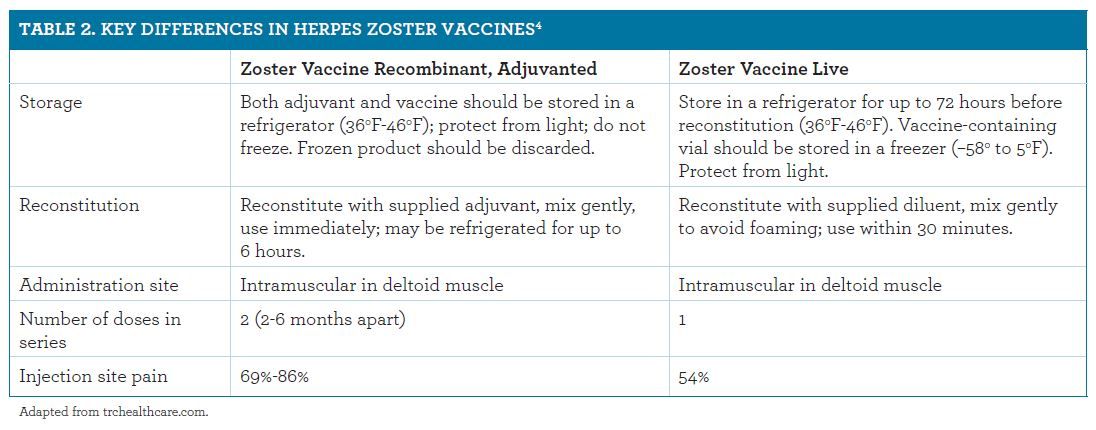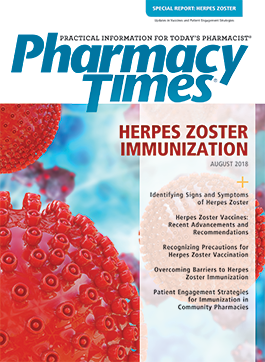Herpes Zoster Vaccination: Recent Advancements and Recommendations
Herpes zoster, commonly known as shingles, is characterized by a painful, itchy rash and blisters, often resulting in permanent neuropathic pain (postherpetic neuralgia) that can be difficult to manage.
Herpes zoster, commonly known as shingles, is characterized by a painful, itchy rash and blisters, often resulting in permanent neuropathic pain (postherpetic neuralgia) that can be difficult to manage.1 It is caused by a reactivation of dormant varicella zoster virus, the same virus that causes chickenpox, in response to immune system compromise.2 Approximately 1 million cases of herpes zoster are diagnosed in the United States each year.1 As age increases, the prevalence of herpes zoster increases in adults. In those aged 50 to 59 years, the incidence ranges from 5 to 11 cases per 1000 population, depending on age.1 Postherpetic neuralgia, which may persist after the rash disappears, occurs in approximately 10% to 13% of cases.1
Herpes Zoster Vaccine: Background and Trial Data
In 2006, the FDA approved zoster vaccine live (ZVL) (Zostavax) for use in immunocompetent adults 50 years and older for the prevention of herpes zoster and its complications.2,3 Because vaccine efficacy has not been studied long term in those patients aged 50 to 59 years, the CDC and the Advisory Committee on Immunization Practices (ACIP) recommend the use of ZVL in immunocompetent adults 60 years and older.1 Study results have demonstrated that ZVL efficacy wanes 5 years after the vaccination in those patients 60 years and older.4 Therefore, ACIP recommends waiting until patients are age 60 to administer ZVL to provide protection from herpes zoster when it is needed most.1,4 ZVL is administered as a single subcutaneous injection.2
Several clinical studies have demonstrated efficacy for both ZVL and zoster vaccine recombinant, adjuvanted. Findings from the ZEST study demonstrated 69.8% efficacy rates for ZVL in preventing herpes zoster in patients aged 50 to 59 years, with a median follow-up of 1.3 years.2 Results from the SPS trial showed a 64% efficacy rate in patients aged 60 to 69 years and a 38% efficacy rate in those 70 years and older, suggesting a drop-off in efficacy with advanced age.2 Waning of immunity has also been noted with ZVL since the time of vaccination.4 Study data have shown efficacy rates of less than 35% by 6 years post vaccination.1 The longest study of ZVL demonstrated that estimates of effectiveness were no longer statistically significant after 9 to 11 years.1
In a phase 3 clinical trial, ZVL demonstrated efficacy against postherpetic neuralgia in 65.7% of cases in participants aged 60 to 69 years and 66.8% in those 70 years and older, with a median follow-up of 3.1 years.1
Zoster Vaccine Recombinant, Adjuvanted
ZVL was the only option available for the prevention of herpes zoster until October 2017, when the FDA approved zoster vaccine recombinant, adjuvanted (Shingrix).1 Containing recombinant glycoprotein E in combination with an adjuvant, zoster vaccine recombinant, adjuvanted, is a viral subunit vaccine that increases the body’s immune response.1,5 It is indicated for the prevention of herpes zoster in adults 50 years and older, and it is administered as a series of 2 intramuscular injections given 2 to 6 months apart.1,4,5 ACIP recommends the zoster vaccine recombinant, adjuvanted, for adults over the age of 50, even if they have already received ZVL.4 Additionally, ACIP has expressed a preference for the zoster vaccine recombinant, adjuvanted, over ZVL (Table 1).4

Efficacy rates of zoster vaccine recombinant, adjuvanted, were evaluated in the phase 3 ZOE-50 trial.1,5 Findings indicated that zoster vaccine recombinant, adjuvanted, demonstrated 96.6% efficacy rates in patients aged 50 to 59 years and 97.4% in those aged 60 to 69 years during a median follow-up period of 3.2 years.1 Investigators pooled data from this trial with the ZOE-70 trial and found an efficacy rate of 91.3% in those 70 years and older.1 Median follow-up in ZOE-70 was 3.7 years.1 At a follow-up of 1 year, vaccine efficacy was 97.6% and remained at 84.7% or higher at 3 years.1
Zoster vaccine recombinant, adjuvanted, has also demonstrated efficacy in the prevention of postherpetic neuralgia.5 The efficacy rate was 91.2% in participants 50 years and older and 88.8% in those 70 years and older.1
Comparing the Vaccines
There are several important differences between the 2 herpes zoster vaccines that are worth exploring in more detail (Table 2).4

Zoster vaccine recombinant, adjuvanted, has clinical advantages over ZVL, in part because it is produced using recombinant DNA technology and is not likely to cause disease. In contrast, varicella-type rashes were reported in rare instances with ZVL in clinical trials.2 Additionally, cases of herpes zoster have been reported in immunocompetent patients, and life-threatening or fatal complications have been reported in immunocompromised patients following ZVL administration.1,2 Zoster vaccine recombinant, adjuvanted, contains an adjuvant for a stronger and more persistent immune response.5 Clinical trial results have demonstrated improved and longer-lasting efficacy compared with ZVL, and studies are under way to evaluate safety in those who are immunocompromised.1
ZVL may be administered to patients 60 years and older.3 Some patients may prefer a 1-dose option to a 2-dose series for ZVL.3 It is important to remind patients 60 years and older that zoster vaccine recombinant, adjuvanted, is preferred by the CDC.1,3,4 However, ZVL may be used if a patient requests immediate vaccination if the zoster vaccine recombinant, adjuvanted, is not available at the time of the vaccine or if the patient is allergic.4
ZVL is a live, attenuated vaccine and is contraindicated in those with immunosuppression because of conditions or therapies. These may include primary or acquired immunodeficiency states, AIDS, and other clinical manifestations of infection with HIV or leukemia, lymphoma, or other malignancies affecting the bone marrow or lymphatic system.4 Vaccinations should be deferred for at least 4 weeks after immunosuppressive therapy has been discontinued.5 However, ZVL may be administered to those taking a low-dose immunosuppressive therapy (eg, less than 14 days of corticosteroid use, less than 20 mg daily of prednisone or its equivalent, or a topical or inhaled corticosteroid).4
ZVL is also contraindicated in patients with a history of anaphylactic or anaphylactoid reactions to gelatin, neomycin, or any other component of the vaccine.2 ZVL should not be administered to women who are pregnant or may become pregnant, and women should wait at least 4 weeks after the vaccination to become pregnant.2
The CDC recommends administering ZVL at the same time as other vaccines, such as the pneumococcal vaccine and other inactivated vaccines.1 Injection site reactions (pain, redness, and swelling) have been reported in 63.6% of patients receiving ZVL in the ZEST study and 48% in the SPS trial. However, only 0.9% reported symptoms as grade 3 or adverse effects that limited daily activity.1,2
The CDC/ACIP recommends 2 doses of zoster vaccine recombinant, adjuvanted, 2 to 6 months apart in patients 50 years and older for the prevention of herpes zoster.1,5 The series does not need to be restarted if more than 6 months have elapsed since the first dose, but there are no studies to evaluate these alternative scenarios. Individuals may be at greater risk of developing herpes zoster if there is a longer interval between doses.1 Zoster vaccine recombinant, adjuvanted, should be administered regardless of a patient’s history of herpes zoster, varicella, or a previous ZVL dose.1 It is also advisable to administer zoster vaccine recombinant, adjuvanted, at least 2 months after a dose of ZVL.1
Like ZVL, zoster vaccine recombinant, adjuvanted, may be administered to those taking a low-dose immunosuppressive therapy (eg, less than 14 days of corticosteroid use, less than 20 mg daily of prednisone or its equivalent, or a topical or inhaled corticosteroid), anticipating immunosuppression, or recovering from an immunocompromising illness.1
Zoster vaccine recombinant, adjuvanted, should not be given to patients currently experiencing an episode of herpes zoster.1 There is no specific waiting period, but the zoster rash should be clear before administering the vaccine.6 Also, individuals with a history of severe allergic reaction to the vaccine or any component of the vaccine should not receive it.1 Those who are known to be seronegative for varicella should not receive zoster vaccine recombinant, adjuvanted.1 Consider delaying zoster vaccine recombinant, adjuvanted, in patients who are pregnant or breast-feeding, as the vaccine has not been evaluated in these populations or in those who are moderately or severely ill.1
Zoster vaccine recombinant, adjuvanted, may be administered with other vaccines, including influenza and pneumococcal vaccines.1 The safety of concomitant administration of 2 adjuvanted vaccines, such as ZVL and influenza virus vaccine, surface antigen, inactivated, and adjuvanted with MF59C.1 (Fluad), has not been evaluated.1
The most commonly reported adverse effects with zoster vaccine recombinant, adjuvanted, administration in clinical trials included pain (78%), swelling (25.9%), and redness (38.1%) at the injection site.5 Tiredness, muscle pain, headache, shivering, fever, stomach pain, and nausea were also reported.5 Approximately 1 of 6 patients reported grade 3 adverse effects.5
Conclusions
Zoster vaccine recombinant, adjuvanted, represents an advancement in the prevention of herpes zoster and its complications. It provides a greater and longer-lasting immune response for better protection and is preferred by ACIP over ZVL. Advise patients that both doses of zoster vaccine recombinant, adjuvanted, must be administered to receive the full benefit of the vaccine, even if they have received ZVL in the past. Also, it is important to set up reminders and speak with patients when they return to the pharmacy for refills. Advise patients that there may be may injection site pain and redness, but these symptoms generally dissipate after a few days and typically do not get worse with the second dose of the vaccine.3,4
APRIL M. HOPPER, PHARMD, is manager of the Rite Aid Drug Information Center in Pittsburgh, Pennsylvania.
References
- Dooling KL, Guo A, Patel M, et al. Recommendations of the Advisory Committee on Immunization Practices for use of herpes zoster vaccines. MMWR Morb Mortal Wkly Rep. 2018;67(3):103-108. doi: 10.15585/mmwr.mm6703a5.
- Zostavax (Zoster Vaccine Live) [prescribing information]. Whitehouse Station, NJ: Merck & Co Inc; 2018. merck.com/product/usa/pi_circulars/z/zostavax/zostavax_pipdf. Accessed July 26, 2018.
- Zoster vaccine: CDC answers your questions. Immunization Action Coalition website. immunize.org/catg.d/p2025.pdf. Accessed July 3, 2018.
- Shingles vaccine: FAQs. Therapeutic Research Center website. trchealthcare.com. Published 2017.
- Zoster Vaccine - Recombinant, Adjuvanted (Shingrix) [package insert]. Research Triangle Park, NC: GlaxoSmithKline; 2017. gsksource.com/shingrix. Accessed July 3, 2018.
- Vaccines and preventable diseases: shingles vaccination. CDC website. cdc.gov/vaccines/vpd/shingles/public/shingrix/index.html. Updated June 13, 2018. Accessed July 18, 2018.

